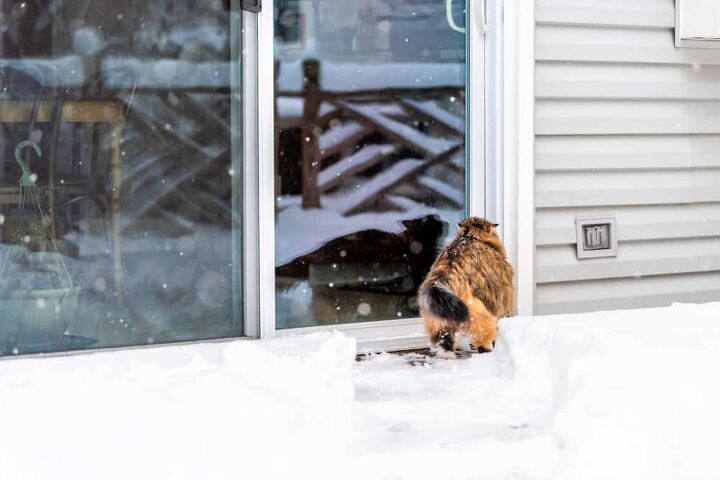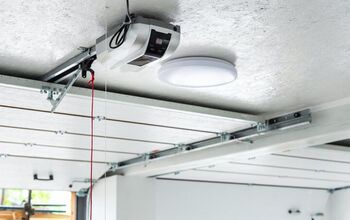How To Weatherproof A Sliding Glass Door (Step-by-Step Guide)

Winter is the time of year you want to hibernate inside, away from the cold and rain, until the welcome return of spring with its milder climate and longer days. To ensure your home will keep you cozy and at a comfortable temperature throughout the harsh cold months, it is vital to spend the time weatherproofing your sliding glass door.
To weatherproof a sliding glass door, you will first need to clean any debris from the door track. Afterward, make sure you install some new weather stripping, insulate the glass with plastic, and then seal your door. This will ensure that no heat escapes your home and also that no cold drafts can enter.
This guide will walk you through the proper steps in weatherproofing your sliding glass door so that you can do this on your own without paying hundreds of dollars to buy a new door or hire a professional. If you’re new to the DIY world, don’t worry, this is an easy project.
Do You Need Weatherstripping Installation or Replacement?
Get free, zero-commitment quotes from pro contractors near you.

Why Should You Weatherproof Your Sliding Glass Door?
Sliding doors are an attractive feature of any home. Unfortunately, they are a significant cause of heat loss and cold drafts. Therefore, if you want to control your heating costs and maintain your home at a comfortable temperature during the winter — you need to ensure your sliding patio door is well-prepared.
Glass doesn’t provide effective insulation; it cannot trap heat inside or prevent cold air from entering. If you leave your doors unprepared, your home will become less energy-efficient, and your heating costs will rise.
How To Weatherproof A Sliding Glass Patio Door
Sliding patio doors are essential, yet preparing them for winter is often a neglected task. They can be responsible for a great deal of heat loss from the home’s interior and allow cold drafts to enter the house.
Fortunately, preparing a sliding glass door for winter is easy and inexpensive. Below we list five steps to help make glass doors work to your advantage when the temperature drops.
Step 1: Remove Debris
Sliding glass doors tend to accumulate debris such as leaves and dust around their base. Due to their size, they attract debris into the track, such as:
- Leaves
- Gravel
- Soil
- Other items blown around by strong winds
The amount of debris that gathers on or around sliding glass doors can be tremendous in only a short time. As a result, one of the most effective ways to keep your doors trouble-free and work correctly is to clean them regularly.
Instructions
- Sweep the door track. Take a few minutes to sweep the track to remove any debris that’s inside of it. You can also use a vacuum to reach any areas that are hard to get with the broom.
- Blow the dirt away from the door. Using a motorized blower, get all of the dirt out that’s around your door and inside of the track. This will ensure that no dirt is present when you install the new weather stripping.
- Wash the track. If the track is filthy, take some time to wash it with some soap and water. You can dilute a few drops of dawn dish soap in a bucket of hot water.
- Dry the area. Ensure you get all the moisture up so that it doesn’t become a breeding ground for mold.
Step 2: Install New Weatherstripping
Weatherstripping is an inexpensive product that can be an instrumental part of your winterization toolkit. Once you have ensured that your sliding glass doors are free of debris, weatherstripping can be used to create an effective seal.
You may want to experiment with different varieties of weatherstripping, such as foam-filled, felt, or V-strip, to identify the one which best suits the needs of your doors. However, foam is the most common, so that we will provide the instructions for that particular type. No matter your choice, the instructions should be included with your materials.
Instructions
- Measure and cut. Measure the dimensions of your sliding glass door’s stop moulding. This is the area where the door fits into the part of the wall when it closes. Then, transfer those measurements to your foam, and make sure you cut about 1/2″ larger than the measurements. It’s better to have a piece that’s too big than one that’s too small.
- Shave the edges. Once you measure it up to your door’s space, use a blade to shave the foam to fit perfectly. You may not need to do this, however.
- Apply the foam. Peel the back off of the foam stripping and apply it to your stop moulding on the inside track of your door. This should fit in this snug, and it shouldn’t prevent your door from shutting or locking. If it does, adjust as needed.
Step 3: Insulate With Plastic
If you live in an area where severe winter weather can be expected, you may already consider shrink-wrapping your windows to minimize heat loss. However, have you thought about taking a similar step with your glass doors?
The shrink wrap will create a significant insulation barrier, which will reduce help to exclude cold air. The only downside is that it is not very attractive. However, it is a useful tool in your fight to keep your home warm and cozy during the chilly winter months.
Instructions
- Purchase a glass door kit shrinkwrap kit. Home Depot and Lowes have shrinkwrap insulation kits you can purchase for your sliding glass door. These are best because they will still allow light into your home while providing adequate insulation. You won’t have to deal with the large, heavy plastic tarps.
- Read the instructions. Each kit has its instructions, so make sure you read them before continuing.
- Apply the plastic. Set the plastic against your door per the instructions included with your kit
- Use your hairdryer. Take your hairdryer and turn it on the highest setting. Make sure you blow the hot air around the edges and keep the plastic taut against the surface. When you’re finished, there should be no air bubbles or peeling around the edges.
Step 4: Install Panels of Rigid Foam Insulation
When the temperatures drop, it’s common for frost to develop, not only on the outside but also inside a badly-insulated sliding glass door. One potential solution to consider is a panel of rigid foam insulation. The instructions will be provided with the product that you purchase.
This is ultra-light and easy to install. You have the option of covering the entire unit or just the part that doesn’t move. The panels typically stretch from the base of the patio door to above the top of the door.
Instructions
- Take measurements. Measure the height and width of the glass on your door. You can then bring these measurements into any home improvement store and search for the side of the foam boards you need.
- Apply the foam. Apply the foam to the glass, and make sure that all or at least most of it is covered.
- Tape it into place. You can use duct tape to secure the edges of the foam to your sliding glass door. It’s that easy.
Step 5: Install Insulated Drapes
Many different products exist to reduce the cold drafts, which can pass through sliding glass doors. The glass on its own is a poor insulator, but you can place additional elements that significantly reduce exposure to cold air, such as:
- Insulated curtains
- Cellular blinds
- Blackout drapes
The initial investment may soon be recouped via the reduction in your utility costs. It will also allow you to sit or relax near the glass doors, as often the kitchen table is situated nearby.
Related Questions
Do You Need Weatherstripping Installation or Replacement?
Get free, zero-commitment quotes from pro contractors near you.

Stay Warm This Winter – Winterize Your Patio Door
Just a few simple steps can ensure that you’ll stay cozy when the cold winter weather comes. Avoid concentrating all your insulation efforts on your regular windows, as sliding glass doors can play a significant role in regulating the temperature inside your home.
Make sure you read each product’s instructions, as the instructions will change depending on the brand and type of product you choose. Regardless, they all work relatively the same and help protect the inside of your home from cold drafts and unpleasant weather during the winter and fall months.

Heather is a passionate writer who loves anything DIY. Growing up, she learned everything from home repairs to design, and wants to share her tips with you. When she's not writing, she's usually hiking or searching for her next DIY project.
More by Heather Robbins



























